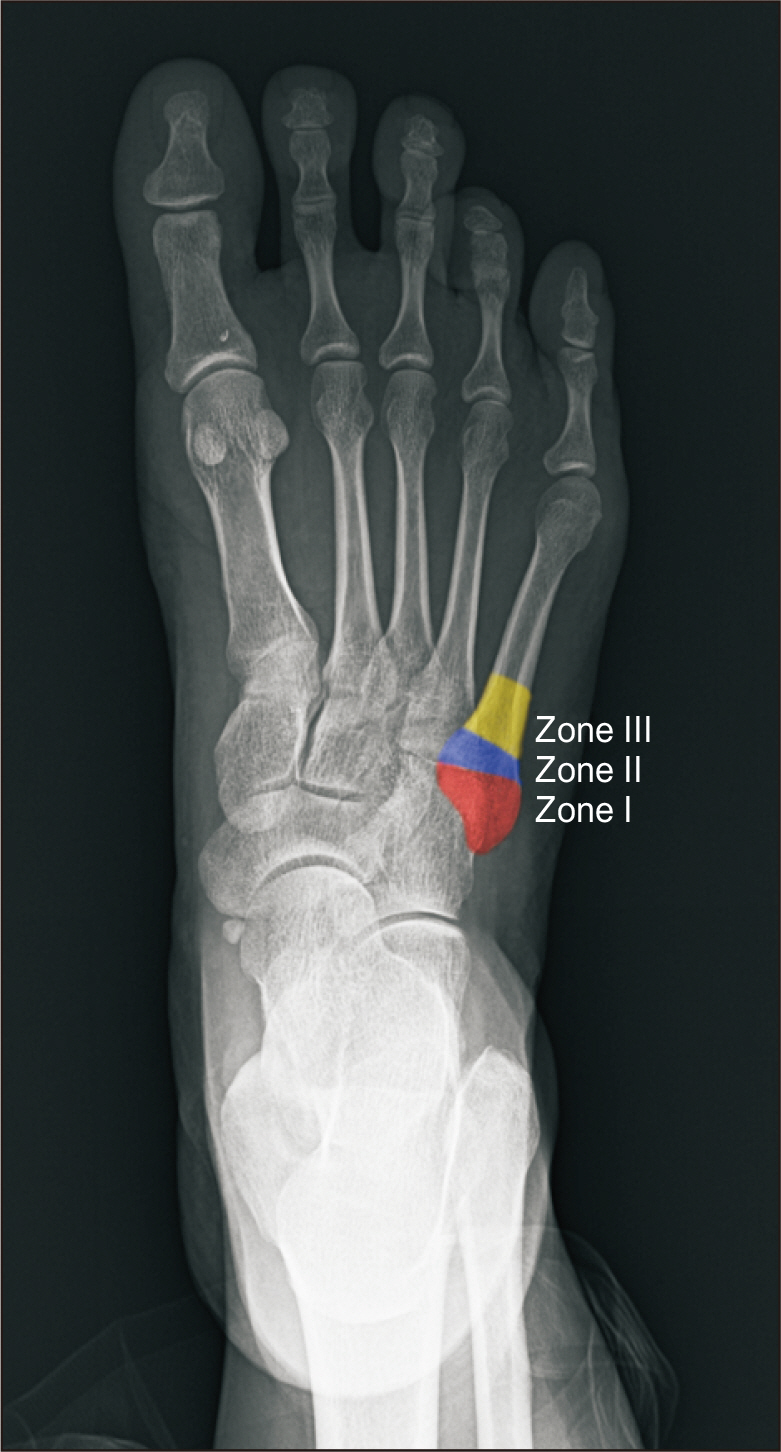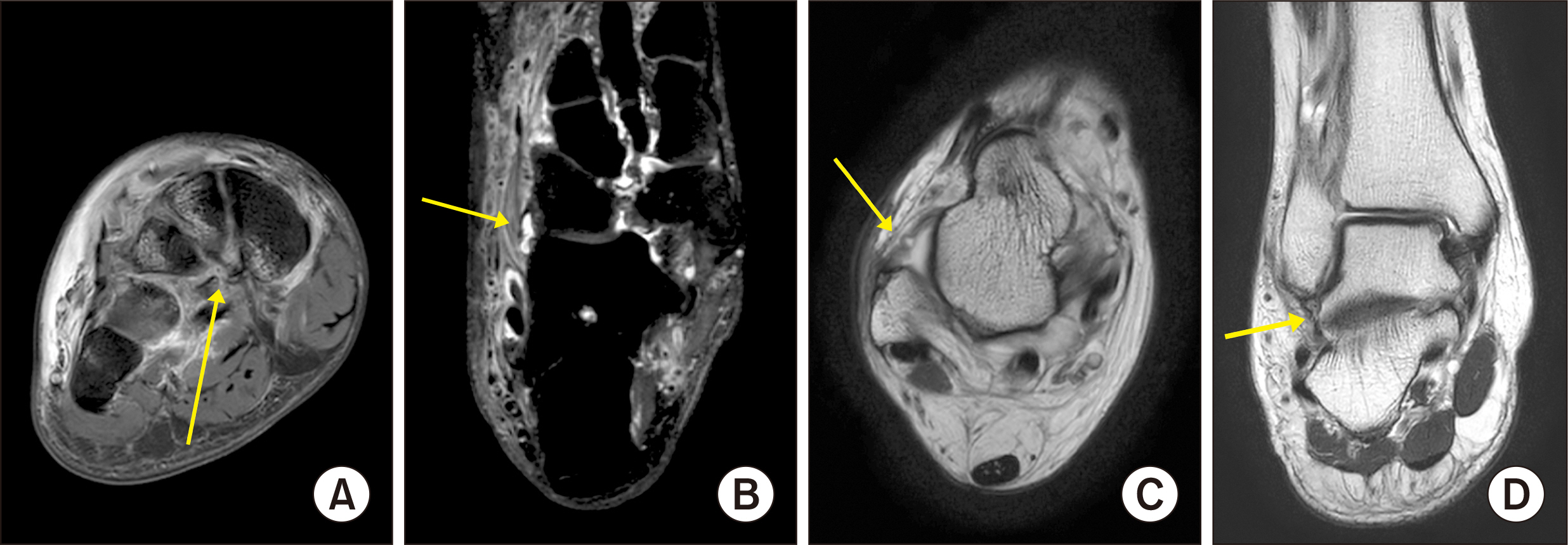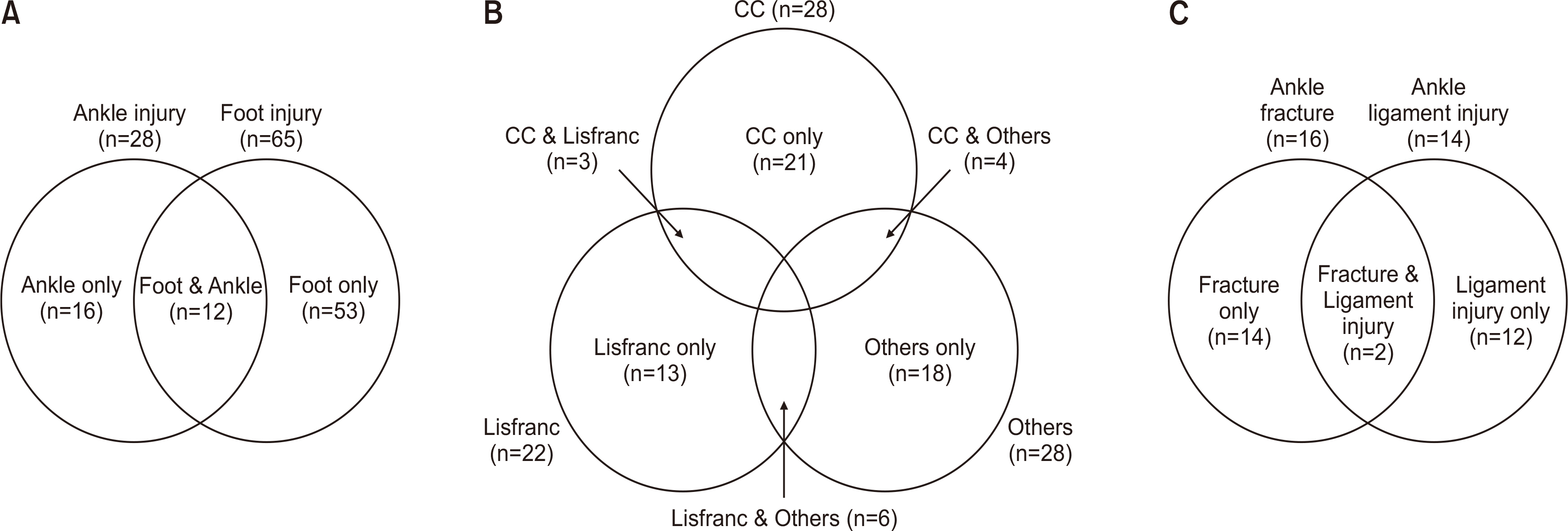J Korean Foot Ankle Soc.
2022 Dec;26(4):163-170. 10.14193/jkfas.2022.26.4.163.
Ankle and Foot Injuries Accompanying 5th Metatarsal Fractures
- Affiliations
-
- 1Department of Orthopedic Surgery, Kangdong Sacred Heart Hospital, Seoul, Korea
- KMID: 2536711
- DOI: http://doi.org/10.14193/jkfas.2022.26.4.163
Abstract
- Purpose
The proximal fifth metatarsal fracture is one of the most common foot fractures. However, few studies have evaluated the associated injuries in patients with a proximal fifth metatarsal fracture. The purpose of this study was to investigate the incidence of foot and ankle joint injuries associated with proximal fifth metatarsal fractures and compare the incidence of these injuries based on the injury mechanisms and location of the fracture.
Materials and Methods
This retrospective study included 157 patients with a proximal fifth metatarsal fracture who underwent surgery from January 2014 to August 2021. Their medical records and radiology images were reviewed to classify and analyze the associated injuries. The proximal fifth metatarsal fractures were classified using Lawrence and Botte's classification. Injury mechanisms were divided into direct and indirect injuries. The incidence of injuries was statistically analyzed according to the injury mechanism and classification.
Results
Of the 157 patients with proximal fifth metatarsal fractures, 81 (51.6%) were diagnosed with foot and ankle joint injuries. The incidence of foot injuries was 65.4%, that of ankle joint injuries was 19.8%, and of both foot and ankle joint injuries was 14.8%. In patients with direct injuries, the incidence of foot and ankle joint injuries was 82.5% and that of indirect injuries was 41.0%. Statistical differences were observed between the incidence of direct and indirect injuries (p<0.001). The incidence of injuries, according to Lawrence and Botte’s classification, was 54.9% (Zone I), 41.2% (Zone II), and 50.0% (Zone III) respectively. However, there were no statistically significant variations in the locations of the proximal fifth metatarsal fractures (p=0.051).
Conclusion
In this study, the incidence of foot and ankle joint injuries associated with proximal fifth metatarsal fractures was found to be high. Therefore, a careful physical examination and appropriate radiological evaluation are recommended for patients with such fractures.
Keyword
Figure
Reference
-
References
1. Dameron TB Jr. 1975; Fractures and anatomical variations of the proximal portion of the fifth metatarsal. J Bone Joint Surg Am. 57:788–92. DOI: 10.2106/00004623-197557060-00010.2. Jones R. 1902; I. Fracture of the base of the fifth metatarsal bone by indirect violence. Ann Surg. 35:697–700.2.3. Torg JS. 1990; Fractures of the base of the fifth metatarsal distal to the tuberosity. Orthopedics. 13:731–7. doi: 10.3928/0147-7447-19900701-09. DOI: 10.3928/0147-7447-19900701-09. PMID: 2197611.4. Lawrence SJ, Botte MJ. 1993; Jones' fractures and related fractures of the proximal fifth metatarsal. Foot Ankle. 14:358–65. doi: 10.1177/107110079301400610. DOI: 10.1177/107110079301400610. PMID: 8406253.5. Bowes J, Buckley R. 2016; Fifth metatarsal fractures and current treatment. World J Orthop. 7:793–800. doi: 10.5312/wjo.v7.i12.793. DOI: 10.5312/wjo.v7.i12.793. PMID: 28032031. PMCID: PMC5155254.6. Cheung CN, Lui TH. 2016; Proximal fifth metatarsal fractures: anatomy, classification, treatment and complications. Arch Trauma Res. 5:e33298. doi: 10.5812/atr.33298. DOI: 10.5812/atr.33298. PMID: 28144601. PMCID: PMC5251206.7. Kane JM, Sandrowski K, Saffel H, Albanese A, Raikin SM, Pedowitz DI. 2015; The epidemiology of fifth metatarsal fracture. Foot Ankle Spec. 8:354–9. doi: 10.1177/1938640015569768. DOI: 10.1177/1938640015569768. PMID: 25666689.8. Andermahr J, Helling HJ, Maintz D, Mönig S, Koebke J, Rehm KE. 2000; The injury of the calcaneocuboid ligaments. Foot Ankle Int. 21:379–84. doi: 10.1177/107110070002100504. DOI: 10.1177/107110070002100504. PMID: 10830655.9. Melão L, Canella C, Weber M, Negrão P, Trudell D, Resnick D. 2009; Ligaments of the transverse tarsal joint complex: MRI-anatomic correlation in cadavers. AJR Am J Roentgenol. 193:662–71. doi: 10.2214/AJR.08.2084. DOI: 10.2214/AJR.08.2084. PMID: 19696279.10. Mahajan V, Chung HW, Suh JS. 2011; Fractures of the proximal fifth metatarsal: percutaneous bicortical fixation. Clin Orthop Surg. 3:140–6. doi: 10.4055/cios.2011.3.2.140. DOI: 10.4055/cios.2011.3.2.140. PMID: 21629475. PMCID: PMC3095785.11. Briet JP, Hietbrink F, Smeeing DP, Dijkgraaf MGW, Verleisdonk EJ, Houwert RM. 2019; Ankle fracture classification: an innovative system for describing ankle fractures. J Foot Ankle Surg. 58:492–6. doi: 10.1053/j.jfas.2018.09.028. DOI: 10.1053/j.jfas.2018.09.028. PMID: 30795890.12. Tartaglione JP, Rosenbaum AJ, Abousayed M, DiPreta JA. 2015; Classifications in brief: Lauge-Hansen classification of ankle fractures. Clin Orthop Relat Res. 473:3323–8. doi: 10.1007/s11999-015-4306-x. DOI: 10.1007/s11999-015-4306-x. PMID: 25900357. PMCID: PMC4562928.13. Kitsukawa K, Hirano T, Niki H, Tachizawa N, Mimura H. 2022; The diagnostic accuracy of MRI to evaluate acute Lisfranc joint injuries: comparison with direct operative observations. Foot Ankle Orthop. 7:24730114211069080. doi: 10.1177/24730114211069080. DOI: 10.1177/24730114211069080. PMID: 35097492. PMCID: PMC8792696.14. Joshy S, Abdulkadir U, Chaganti S, Sullivan B, Hariharan K. 2010; Accuracy of MRI scan in the diagnosis of ligamentous and chondral pathology in the ankle. Foot Ankle Surg. 16:78–80. doi: 10.1016/j.fas.2009.05.012. DOI: 10.1016/j.fas.2009.05.012. PMID: 20483139.15. Kim TH, Moon SG, Jung HG, Kim NR. 2017; Subtalar instability: imaging features of subtalar ligaments on 3D isotropic ankle MRI. BMC Musculoskelet Disord. 18:475. doi: 10.1186/s12891-017-1841-5. DOI: 10.1186/s12891-017-1841-5. PMID: 29162077. PMCID: PMC5696773.16. Polzer H, Polzer S, Mutschler W, Prall WC. 2012; Acute fractures to the proximal fifth metatarsal bone: development of classification and treatment recommendations based on the current evidence. Injury. 43:1626–32. doi: 10.1016/j.injury.2012.03.010. DOI: 10.1016/j.injury.2012.03.010. PMID: 22465516.17. Turgut A, Uzakgider M, Altun O, Egeli E, Erkuş S, Kalenderer Ö. 2021; Ankle joint injuries accompanying fifth metatarsal base fractures. J Am Podiatr Med Assoc. 111:Article_11. doi: 10.7547/19-032. DOI: 10.7547/19-032. PMID: 32915953.18. Cao H, Li N, Wang G, He J. 2022; Therapy strategies of fifth metatarsal base fracture with lateral collateral ligament injury. J Orthop Surg Res. 17:45. doi: 10.1186/s13018-022-02935-7. DOI: 10.1186/s13018-022-02935-7. PMID: 35073951. PMCID: PMC8785510.19. Renninger CH, Cochran G, Tompane T, Bellamy J, Kuhn K. 2017; Injury characteristics of low-energy Lisfranc injuries compared with high-energy injuries. Foot Ankle Int. 38:964–9. doi: 10.1177/1071100717709575. DOI: 10.1177/1071100717709575. PMID: 28693353.20. Leland RH, Marymont JV, Trevino SG, Varner KE, Noble PC. 2001; Calcaneocuboid stability: a clinical and anatomic study. Foot Ankle Int. 22:880–4. doi: 10.1177/107110070102201104. DOI: 10.1177/107110070102201104. PMID: 11722139.21. Wiley JJ. 1971; The mechanism of tarso-metatarsal joint injuries. J Bone Joint Surg Br. 53:474–82. DOI: 10.1302/0301-620X.53B3.474. PMID: 5562373.22. Pituckanotai K, Arirachakaran A, Piyapittayanun P, Tuchinda H, Peradhammanon E, Kongtharvonskul J. 2018; Comparative outcomes of cast and removable support in fracture fifth metatarsal bone: systematic review and meta-analysis. J Foot Ankle Surg. 57:982–6. doi: 10.1053/j.jfas.2018.03.018. DOI: 10.1053/j.jfas.2018.03.018. PMID: 30149851.23. Baumbach SF, Prall WC, Kramer M, Braunstein M, Böcker W, Polzer H. 2017; Functional treatment for fractures to the base of the 5th metatarsal - influence of fracture location and fracture characteristics. BMC Musculoskelet Disord. 18:534. doi: 10.1186/s12891-017-1893-6. DOI: 10.1186/s12891-017-1893-6. PMID: 29246170. PMCID: PMC5732483.24. Zenios M, Kim WY, Sampath J, Muddu BN. 2005; Functional treatment of acute metatarsal fractures: a prospective randomised comparison of management in a cast versus elasticated support bandage. Injury. 36:832–5. doi: 10.1016/j.injury.2004.12.001. DOI: 10.1016/j.injury.2004.12.001. PMID: 15949484.25. Wiener BD, Linder JF, Giattini JF. 1997; Treatment of fractures of the fifth metatarsal: a prospective study. Foot Ankle Int. 18:267–9. doi: 10.1177/107110079701800504. DOI: 10.1177/107110079701800504. PMID: 9167925.26. Vorlat P, Achtergael W, Haentjens P. 2007; Predictors of outcome of non-displaced fractures of the base of the fifth metatarsal. Int Orthop. 31:5–10. doi: 10.1007/s00264-006-0116-9. DOI: 10.1007/s00264-006-0116-9. PMID: 16721621. PMCID: PMC2267534.
- Full Text Links
- Actions
-
Cited
- CITED
-
- Close
- Share
- Similar articles
-
- 5th MTP Joint Reconstruction with Autogenic Costal Osteochondral Graft
- Brachymetatarsia
- Predisposing Factors and Treatment for the Fifth Proximal Metatarsal Fracture
- Fifth Metatarsal Stress Fracture
- Closed Reduction and Fixation of Metatarsal Head and Neck Fractures Using Antegrade Intramedullary K-wire (6 Cases Report)





